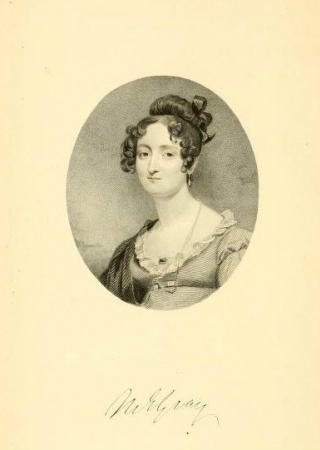Maria Emma Gray
- Maria bequeathed her collection of shell specimens to the Cambridge University Museum?
- Maria's second, and final, husband, John Edward Gray was so thankful for her contributions to his scientific works that he had a bronze medallion struck in her honor with both of their likenesses on it in 1863?
- In 1866, to further honor Maria's dedication to the study of algae, her husband, John, created the algae genus Grayemma in her honor?
- The Grayemma menziesii algae is a marine algae distributed in Florida, the Gulf of Mexico, the Bahamas, and the tropic and subtropic West Atlantic Ocean?
- 1787 Maria Emma (Smith) Gray is born in the Royal Naval Hospital in Kent where her father is a resident RN.
- 1812 Maria marries Francis Edward Gray, has two daughters.
- 1814 Francis passes away.
- 1822-1826 Maria cultivates a friendship with her former husband's cousin, John Edward Gray, and introduces him to her circle of friends.
- 1826 Maria marries John and he encourages her interest in conchology and algology.
- 1826-1875 Maria and John are faithful companions dedicated to scientific study; she helps him with many of his texts but is unlisted in the credits.
- 1842-1874 Maria etches plates for a 5-volume work, Figures of Molluscous Animals.
- 1859 Maria arranges the algae in the herbaria at Kew and the British Museum.
- 1875 John passes away.
- 1876 Maria passes away.
Maria Emma Gray (1787-1876) was born at the Royal Naval Hospital, Greenwich, Kent. At the time, her father, Lieutenant Henry Smith RN, was a resident at the Hospital. In 1812 Maria was wed to Francis Edward Gray and had two daughters soon after. By 1814, Maria was widowed. At some point between 1822 and 1826, John Edward Gray--zoologist, museum curator and cousin to Maria's first husband, became close to Maria. In the 1820's, John was encouraged by his father to enter the medical profession but was repulsed by surgery and also failed to attain an assistantship at the British Museum. As a result, John suffered a nervous breakdown, and his friendship with Maria and her introduction of him to her circle of friends provided a great support network for his recovery. In 1826, Maria and John married, and this allowed Maria to pursue her scientific interests along with her scientifically-minded husband.
Between 1842 and 1874 she etched 5 volumes of plates for Figures of Molluscous Animals. In 1859 she arranged algae in the Kew and British Museum herbaria. Maria and John's marriage was long and happy. John reportedly said, "my wife has been my companion and helper in all my studies. . .and my cares." Maria continued to study algae and was considered a respected algologist and conchologist by her male contemporaries. She mounted and arranged the majority of the Cuming collection of shells in the British Museum. She also arranged many sets of shells for schools throughout Britain to encourage the study and provide much needed study resources.
John passed away in 1875 and Emma one year later. She was, and is, valued as a great technical artist of biodiversity, as a researcher of algae and shells, and as an unlisted contributor to many of her husband's scientific works.




